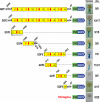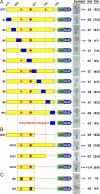Identification of cis-regulatory sequences that activate transcription in the suspensor of plant embryos
- PMID: 19208800
- PMCID: PMC2638740
- DOI: 10.1073/pnas.0813276106
Identification of cis-regulatory sequences that activate transcription in the suspensor of plant embryos
Abstract
Little is known about the molecular mechanisms by which the embryo proper and suspensor of plant embryos activate specific gene sets shortly after fertilization. We analyzed the upstream region of the scarlet runner bean (Phaseolus coccineus) G564 gene to understand how genes are activated specifically within the suspensor during early embryo development. Previously, we showed that the G564 upstream region has a block of tandem repeats, which contain a conserved 10-bp motif (GAAAAG(C)/(T)GAA), and that deletion of these repeats results in a loss of suspensor transcription. Here, we use gain-of-function (GOF) experiments with transgenic globular-stage tobacco embryos to show that only 1 of the 5 tandem repeats is required to drive suspensor-specific transcription. Fine-scale deletion and scanning mutagenesis experiments with 1 tandem repeat uncovered a 54-bp region that contains all of the sequences required to activate transcription in the suspensor, including the 10-bp motif (GAAAAGCGAA) and a similar 10-bp-like motif (GAAAAACGAA). Site-directed mutagenesis and GOF experiments indicated that both the 10-bp and 10-bp-like motifs are necessary, but not sufficient to activate transcription in the suspensor, and that a sequence (TTGGT) between the 10-bp and the 10-bp-like motifs is also necessary for suspensor transcription. Together, these data identify sequences that are required to activate transcription in the suspensor of a plant embryo after fertilization.
Conflict of interest statement
The authors declare no conflict of interest.
Figures





Similar articles
-
A cis-regulatory module activating transcription in the suspensor contains five cis-regulatory elements.Plant Mol Biol. 2015 Jun;88(3):207-17. doi: 10.1007/s11103-015-0308-z. Epub 2015 Mar 22. Plant Mol Biol. 2015. PMID: 25796517 Free PMC article.
-
A shared cis-regulatory module activates transcription in the suspensor of plant embryos.Proc Natl Acad Sci U S A. 2018 Jun 19;115(25):E5824-E5833. doi: 10.1073/pnas.1805802115. Epub 2018 Jun 4. Proc Natl Acad Sci U S A. 2018. PMID: 29866850 Free PMC article.
-
Regional localization of suspensor mRNAs during early embryo development.Plant Cell. 2001 Nov;13(11):2409-25. doi: 10.1105/tpc.010326. Plant Cell. 2001. PMID: 11701878 Free PMC article.
-
Comparative analysis of embryo proper and suspensor transcriptomes in plant embryos with different morphologies.Proc Natl Acad Sci U S A. 2021 Feb 9;118(6):e2024704118. doi: 10.1073/pnas.2024704118. Proc Natl Acad Sci U S A. 2021. PMID: 33536344 Free PMC article.
-
The suspensor: not just suspending the embryo.Trends Plant Sci. 2010 Jan;15(1):23-30. doi: 10.1016/j.tplants.2009.11.002. Epub 2009 Dec 4. Trends Plant Sci. 2010. PMID: 19963427 Review.
Cited by
-
Profile of Robert B. Goldberg.Proc Natl Acad Sci U S A. 2012 Feb 21;109(8):2688-90. doi: 10.1073/pnas.1121586109. Epub 2012 Jan 23. Proc Natl Acad Sci U S A. 2012. PMID: 22308495 Free PMC article. No abstract available.
-
A cis-regulatory module activating transcription in the suspensor contains five cis-regulatory elements.Plant Mol Biol. 2015 Jun;88(3):207-17. doi: 10.1007/s11103-015-0308-z. Epub 2015 Mar 22. Plant Mol Biol. 2015. PMID: 25796517 Free PMC article.
-
A shared cis-regulatory module activates transcription in the suspensor of plant embryos.Proc Natl Acad Sci U S A. 2018 Jun 19;115(25):E5824-E5833. doi: 10.1073/pnas.1805802115. Epub 2018 Jun 4. Proc Natl Acad Sci U S A. 2018. PMID: 29866850 Free PMC article.
-
Non-conventional pathways enable pennycress (Thlaspi arvense L.) embryos to achieve high efficiency of oil biosynthesis.J Exp Bot. 2020 May 30;71(10):3037-3051. doi: 10.1093/jxb/eraa060. J Exp Bot. 2020. PMID: 32006014 Free PMC article.
-
Asymmetric cell division in land plants and algae: the driving force for differentiation.Nat Rev Mol Cell Biol. 2011 Mar;12(3):177-88. doi: 10.1038/nrm3064. Nat Rev Mol Cell Biol. 2011. PMID: 21346731 Review.
References
Publication types
MeSH terms
LinkOut - more resources
Full Text Sources
Miscellaneous

